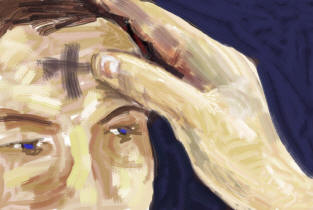
Sarah Bentley Allred at Virginia Theological Seminary has identified 3 teaching points for Ash Wednesday
Ash Wednesday marks the first day of the season of Lent, the forty days set aside to prepare to celebrate the death and resurrection of Jesus.
Before he began his public ministry, Jesus spent forty days in the wilderness, being tempted by Satan, and resisting those temptations. The forty day season of Lent gives us needed time and space to enter into our own wilderness spaces as we examine our lives, acknowledge the ways that evil has slipped into our lives, ask for forgiveness, and make needed course corrections in our lives so that we can whole heartedly follow Jesus. The Ash Wednesday service is our doorway into this Lenten time and space in which we come before God in repentance, praying that God will strengthen our faith.
1 The Call to A Holy Lent “Our liturgy directly invites us into a holy season of specific practices aimed at helping us reconnect with God in preparation for the celebration of Easter. “I invite you, therefore, in the name of the Church, to the observance of a holy Lent.” (Book of Common Prayer, page 265)
We see in this invitation that there are six specific ways which christians are called to deepen their devotion in this season.
A. By self-examination. This means setting aside time to intentionally reflect upon one’s thoughts and actions, acknowledging the ways in which we fall short of God’s goodness and love.
B. By repentance. To repent means to have “a change of heart” and to “turn around” from actions and attitudes contrary to God’s will. This means honestly confessing our sins to God and receiving his forgiveness.
C. By prayer. This calls us to take part in the Church’s corporate acts of worship as well as the setting aside of time for personal prayer.
D. By fasting. To fast is to abstain from certain foods or all food for a period of time. Fasting separates you from the distractions of this world and it brings us into a closer union with God. It allows us to hear God better and fully rely upon Him.
From our 2019 sermon – “Fasting as a discipline is becoming increasingly important in our fractured world– because fasting, not only from food, but from the things that divide us, can bring healing not only to ourselves but to humanity in general. This year, join me in fasting from something that divides you from other people.”
“Examine yourself to see what divides you from others, from the earth and from God, and repent from these divisive things. Prayer, fasting, and denying yourselves these divisive things will be helped by meditating on God’s holy Word.”
E. By self-denial. Denying oneself in Lent means giving up certain luxuries, even legitimate pleasures, in order to focus oneself spiritually.
F. By reading and meditating on God’s holy Word. In Lent, believers are especially called to read and reflect on Scripture in a daily way.
2. We are dust “Many Ash Wednesday liturgies provide an opportunity for worshipers to receive the mark of the cross in ashes on their forehead accompanied by the words, “remember that you are dust, and to dust you shall return.” There are many layers of meaning within this simple, powerful ritual. There is the call to remember God created us from the earth (Genesis 2:7). It is by the grace of God that we live and move and have our being and we are inextricably linked to the earth from which we were created.
“There is also the call to remember our connection to the rest of humanity. We are all made from the same “stuff.” We come from dust and we dwell in skin, bone, blood, and cartilage. And there is the call to remember we will return to the earth from whence we came (Genesis 3:19). Ash Wednesday provides us that rarely comfortable, but certainly important opportunity to sit with our own mortality.”
3. Repentance “To repent is to both acknowledge that we have not loved God with our whole heart and we have not loved our neighbors as ourselves AND to make every effort to do things differently. Repentance is about turning away from behavior that is not in alignment with these two great commandments. Rather than something to check off the to-do list, repentance is a practice. Being human means we will never be fully without sin and we will never outgrow the need for God’s forgiveness”
Ash Wednesday, Feb. 22, 7pm service
Although the imposition of ashes is not a sacrament like baptism or the Eucharist, receiving ashes on the forehead on Ash Wednesday is a valuable reminder of several things. Receiving ashes reminds us that we are created from the earth, and that God’s grace gives us life. Our life is linked to the earth from which we were created.
Receiving ashes reminds us that we are connected the rest of humanity and to all living things. We are ALL made from the earth. We ALL dwell in skin, bone, blood, and cartilage. And we will return to the earth at the end of our lives here on earth. Ashes on our forehead remind us to sit with our own mortality, an important exercise in humility.
Receiving ashes in the Old Testament is a sign of penitence of feeling sorry for our sins. Job repents “in dust and ashes,” and there are other associations of ashes and repentance in Esther, Samuel, Isaiah and Jeremiah.
During the Ash Wednesday service , we will impose ashes on the foreheads of others in our households or place the ashes on our own foreheads if we are alone.


